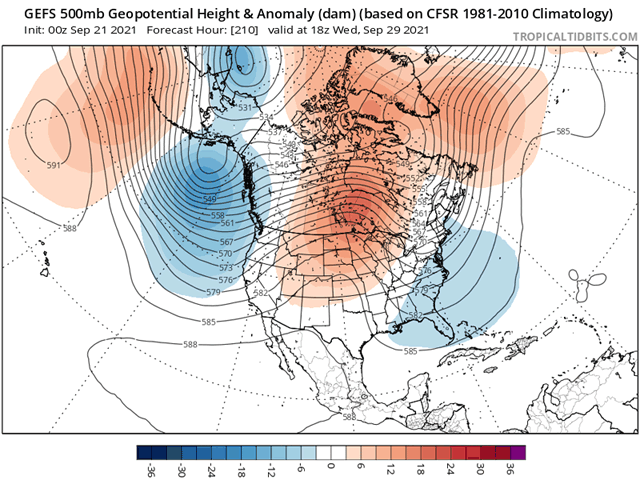Drier, Warmer Pattern Next Week
Heat Ridge Could Dry Wet Soils, Help Early Harvest
A storm system continues to move eastward through the country early this week. It has already brought some good rainfall east of the Plains as it has drawn significant moisture northward from the Gulf of Mexico. Through the morning of Sept. 21, several areas from Minnesota to the Southeast have recorded over an inch of rain since Sept. 18, which has likely caused some delays for maturing crops and harvest activity.
The system should push eastward and northward Sept. 23 and high pressure that has developed behind the system is clearing out chances for rain. This will allow soils to dry out that had harvest delays. While a system may move through the Great Lakes with some isolated showers Sept. 24-25, there will be a large change for much of the country.
P[L1] D[0x0] M[300x250] OOP[F] ADUNIT[] T[]
The return of a ridge in the west this coming weekend will grow across the middle of the continent next week. Ridges typically provide warmer and drier conditions and block systems from moving through the area. This ridge looks to have this effect, but it will not be universal across the country's growing regions.
There are still storm systems and disturbances in the North Pacific and they will try to push through the ridge at times. One looks like it may succeed early next week. That could produce some shower activity across the eastern Midwest into the Northeast and keep temperatures from climbing too high. Otherwise, the ridge will largely succeed and improve conditions for harvest -- drying soils and plants out as temperatures climb sometimes well above normal to close out the month of September and start the month of October.
The conditions are not all good news, however. Winter wheat depends on fall rains and cooler conditions to provide enough moisture for good root growth before going dormant for the winter. The upcoming pattern does not favor either for the Central and Southern Plains. Soil conditions here are drier than normal and some good rains are needed in the country's largest production areas. While it will likely be drier in the Delta and Midwest wheat-growing regions, soil moisture here is more plentiful both from the summer and the rainfall this week.
The Pacific Northwest is also going to see a warmer and drier trend for the next week as the ridge builds. Soil moisture is severely lacking in this region as drought conditions built through the summer. But as the ridge slides more toward the middle of the continent, some of the storm system out in the North Pacific will try to move into the Pacific Northwest. This could bring at least some periodic showers to the region, though it will still be a difficult endeavor to see anything either widespread or heavy enough to make a difference in soil moisture or the outlook for the crop this fall.
Models are pointing to this ridge lasting for about the first week of October before we get into a more variable pattern again. The ridge will still poke up from time to time throughout the month and the country should see below-normal rainfall and above-normal temperatures overall. But while conditions could be rough on winter wheat for the next two weeks, there are some chances for better conditions yet this fall. This is more likely to manifest itself regionally rather than widespread, and we will have to keep an eye out for exactly where showers occur. If we do not see good rainfall over the Southern Plains in October, winter wheat on the whole could end up in bad shape going into 2022.
John Baranick can be reached at john.baranick@dtn.com
(c) Copyright 2021 DTN, LLC. All rights reserved.




